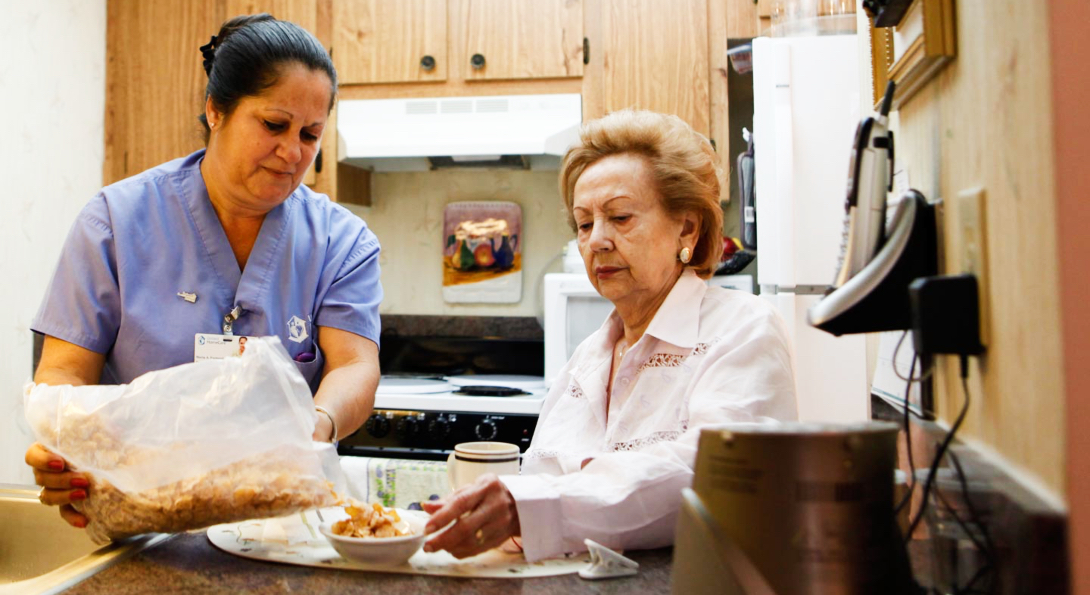Empowering Home Care Aides to Care For Frail Older Adults During COVID-19

Illinoisans transitioned into a new reality of staying home on March 21, 2020, according to the “Shelter-in-place” order issued by Illinois Governor J.B. Pritzker. However, many “essential” workers, medical or non-medical, continue to work in high-risk environments, often to help the most vulnerable in our society.
Home care aides (HCAs) in Illinois’s Community Care Program are among those essential workers. They care for low-asset older adults who need help with daily activities. HCAs provide non-medical assistance with daily activities such as bathing, dressing, transferring, cleaning, cooking and grocery shopping. HCAs are among the nation’s fastest growing occupations. According to the U.S. Bureau of Labor Statistics, more than 3.2 million HCAs, also known as personal care assistants, care for the nation’s growing older populations.
I collaborate with HCAs in a research study that I direct, “Promoting Seniors’ Health with Home Care Aides (Pro-Home),” funded by the National Institute on Aging at the National Institutes of Health. In Pro-Home, HCAs bring a health promoting activity to their clients. Pro-Home is innovative, because it empowers HCAs with user-friendly tools that enable them to play an active, health-promoting role for their clients.
The COVID-19 pandemic has highlighted the importance of empowering HCAs with resources to do their job. HCAs care for older adults with multiple chronic conditions. These older adults are at the highest risk for COVID-19. Much of their formal and informal care has been withdrawn. HCAs are often the only personnel allowed to visit them. However, protective gear, such as gloves, masks, and sanitizers are hard to obtain. A lack of protective gear makes both workers and clients anxious about the virus. HCAs are not medically trained, but they care for the frailest populations. Increased, smooth distribution of protective gear is critical not only in medical facilities but also in community settings where older persons wish to remain.
HCAs work in a high-risk environment for COVID-19. HCAs work in close contact with older adults. Maintaining six-feet distance is not an option. HCAs often use public transportation for commuting. Working for hours in their clients’ homes daily or weekly, HCAs are in contact with their clients and other people in clients’ homes. Shopping groceries for clients has become challenging, as many foods and daily necessities are sold out. Having established long-term relationships with their clients, some HCAs want to continue to help clients with suspected or confirmed COVID-19. Community transmission of COVID-19 is rampant, but testing for the virus is not widely available. HCAs are unknowingly exposed to the virus on and off the job.
Many HCAs are at high risk themselves. HCAs are older than other care workers, such as nursing assistants or home health aides. Approximately 10 percent of HCAs are aged 65 or older. In Chicago, the majority of HCAs are African Americans or workers who speak languages other than English at home. Minority communities have been hit hard by COVID-19. In Chicago, African Americans constitute 30 percent of the population and account for 70 percent of COVID-19 deaths. Those are the communities with high levels of chronic disease and low levels of infrastructure, from access to the Internet to electronics that facilitate remote communication and work.
HCAs receive low wages and limited or no job-related benefits. Staying home while sick means no income to support their family. If clients are hospitalized or deceased, HCAs will have reduced hours and wages. I continue to be awed by HCAs with years and decades of experience and expertise.
I urge policy makers, health professionals, researchers and businesses to acknowledge the value of the essential work that HCAs continue to do during this pandemic. It is time to empower HCA with protective gear, technology to access clients remotely and, most importantly, respect from society. Society depends on those direct care workers to care for older adults, yet HCAs bear the burden of COVID-19 policy blunders. Promoting the safety and health of HCAs is of utmost importance for not only for the workers but also for frail older people whose survival and health depend on their HCAs.
About the author Heading link
Naoko Muramatsu, PhD, is a professor of community health sciences at the University of Illinois at Chicago (UIC) School of Public Health. She is passionate about improving the well-being of aging populations and the quality of long-term care systems. Her research focuses on understanding how place impacts aging, health, work, and caregiving experiences of diverse populations nationally and globally. Her current research develops cost-effective, sustainable community-based health promotion programs in partnership with older adults, caregivers, community-based organizations, and multidisciplinary research teams. Guided by life course perspectives, Dr. Muramatsu uses multilevel longitudinal analysis and mixed methods to understand and intervene upon the complex individual, organizational, and system-level factors that impact aging populations and the quality of health care systems.